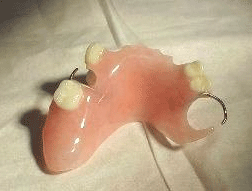|
 |
| |
| |
Crown & Bridges |
Removable Partial Dentures |
Complete Dentures |
| |
| |
THE PLASTIC REMOVABLE PARTIAL DENTURE
|
|
| |
|
|
| |
 |
|
| |
|
|
| |
This is the least expensive of all the removable partial dentures. These dentures are generally used for temporary or intermediary purpose until the final prosthesis is made. Still yet we find many people keep this type of appliance for many, many years, just like permanent ones because as long as they are properly maintained, they look outwardly as good as the more expensive permanent appliances. The one pictured above replaces 4 missing teeth, leaving spaces for 7 natural teeth. Two of the natural teeth are clasped with wrought wire clasps which are cured into the structure of the denture base.
The pink material of the denture base is hard plastic and the same material used to make complete dentures. The main single advantage to this type of RPD is the cost. Also the new teeth and new denture base can easily be added to an existing treatment RPD. These are frequently fabricated even if the remaining teeth have existing decay or periodontal disease and their prognosis is doubtful. If later in the course of treatment some of the existing natural teeth are extracted for any reason, new false teeth can be added quickly to the partial, maintaining the patient's appearance.
Another common and infact more important use of these appliances is as an " immediate partial denture ". This means that the appliance can be made before the teeth are removed, and inserted immediately after the extraction of the planned teeth so that the patient is never without teeth. This is of special help when anterior teeth are to extracted and patient wants to return back to his/her normal routine immediately.
However in spite of these advantages they have a number of disadvantages too.
They are basically plastic and due to their irregular shape, these partials tend to break frequently, especially those made for the lower arch. (Full dentures are more regular in shape and tend to be fairly strong as a result.)
These appliances are less stable compared to cast partials. Also cases of allergy to this material have also been reported.
As the gums resorb, the false teeth tend to sink below their original level making it necessary to reline them frequently, and sometimes even to reset the teeth which adds to their expense.
They are most frequently retained with wire clasps. These are frequently unsightly due to the limitations that pertain to their placement.
|
|
| |
|
|
| |
CAST METAL REMOVABLE PARTIAL DENTURE |
|
| |
|
|
| |
 |
|
| |
|
|
| |
These Removable Partial Dentures are cast metal frameworks made of chrome cobalt.These frameworks are cast to fit the teeth .These are cast very thin and are much less likely to break than the all plastic variety. For the same reason they are much less noticeable to the tongue.
The teeth have to be altered slightly beforehand in order that the partial denture can rest upon them without interfering with the way the patient bites the teeth together. Since they sit on the teeth, as well as being attached to them, they are extremely stable and retentive
The metal framework does not contact the gums. Thus, as the gums resorb, this type of partial does not sink with them and rarely requires relines. |
|
| |
|
|
| |
Advantages |
|
| |
|
|
| |
- Rarely breaks. Can also be used for complete denture cases where breakage is a frequent problem.
- It is made very thin, so less noticeable to tongue
- More stable and retentive
However a major drawback is the visibility of metal clasps which might be objectionable to some patients.
|
|
| |
|
|
|
| |
|
|